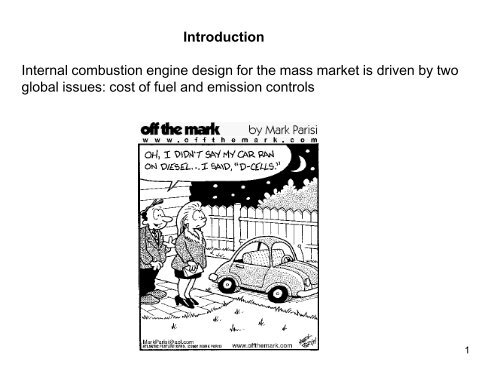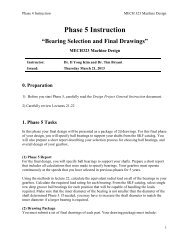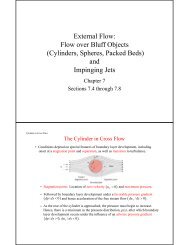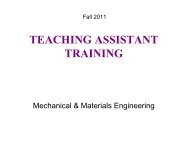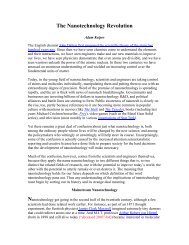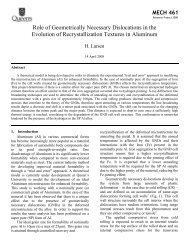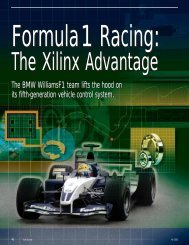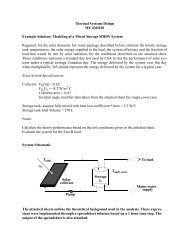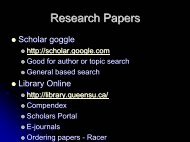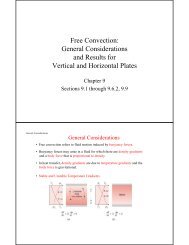Introduction Internal combustion engine design for the mass market ...
Introduction Internal combustion engine design for the mass market ...
Introduction Internal combustion engine design for the mass market ...
Create successful ePaper yourself
Turn your PDF publications into a flip-book with our unique Google optimized e-Paper software.
<strong>Introduction</strong><br />
<strong>Internal</strong> <strong>combustion</strong> <strong>engine</strong> <strong>design</strong> <strong>for</strong> <strong>the</strong> <strong>mass</strong> <strong>market</strong> is driven by two<br />
global issues: cost of fuel and emission controls<br />
1
Price of Crude Oil<br />
Most motor vehicle fuels are derived from crude oil which is not a renewable<br />
commodity<br />
The cost of crude oil is driven by <strong>market</strong> supply and demand<br />
Supply - Crude oil reserves limited to a few countries in <strong>the</strong> world, mainly<br />
<strong>the</strong> Middle East, Canada, Russia, Venezuela (U.S. ?)<br />
Current oil reserves of roughly 1.25 trillion barrels are estimated to be<br />
depleted by 2050-2090 based on annual usage of 100 million barrels<br />
The largest oil reserves are located in unstable countries where conflicts<br />
often affect oil production<br />
Demand - expected to increase as emerging countries such as China<br />
(pop. 1.3 billion) and India (pop. 1.1 billion) prosper<br />
2
Iran<br />
Canada<br />
Russia<br />
Nigeria<br />
Saudi Arabia<br />
Iraq<br />
3
Environmental Concerns<br />
Burning of fossil fuels in internal <strong>combustion</strong> <strong>engine</strong>s produce harmful<br />
emissions that affect <strong>the</strong> health of living creatures on earth<br />
In <strong>the</strong> developed countries <strong>the</strong> government regulates <strong>the</strong> level of harmful<br />
emissions from vehicles (UHC, NOx, SOx, CO, C)<br />
Even <strong>the</strong> emission of chemically stable carbon dioxide (stuff we exhale)<br />
from vehicles contributes to global warming will shortly be regulated<br />
There is a cost associated with meeting <strong>the</strong> vehicular emission standards<br />
which are becoming more and more stringent with time<br />
4
<strong>Internal</strong> Combustion Engine<br />
The internal <strong>combustion</strong> (IC) <strong>engine</strong> is a heat <strong>engine</strong> that converts<br />
chemical energy stored in a fuel into mechanical energy, usually made<br />
available on a rotating output shaft.<br />
History of IC <strong>engine</strong>s:<br />
1700s - Steam <strong>engine</strong>s (external <strong>combustion</strong> <strong>engine</strong>s)<br />
1860 - Lenoir <strong>engine</strong> (η = 5%)<br />
1867 - Otto-Langen <strong>engine</strong> (η = 11%, 90 RPM max.)<br />
1876 - Otto four-stroke “spark ignition” <strong>engine</strong> (η = 14%, 160 RPM max.)<br />
1880s - “Modern” two-stroke <strong>engine</strong><br />
1892 - Diesel four-stroke “compression ignition” <strong>engine</strong><br />
1957 - Wenkel “rotary” <strong>engine</strong><br />
5
P at<br />
m<br />
Pressure<br />
VALVE<br />
1<br />
(VO)<br />
Atmospheric Engine<br />
Process 1-2: Fuel air mixture introduced into cylinder at<br />
atmospheric pressure - valve open (VO)<br />
FLYWHEEL<br />
Process 2-3: Constant pressure <strong>combustion</strong> (cylinder open<br />
to atmosphere)<br />
P atm<br />
2<br />
3<br />
Volume<br />
6
Process 3-4: Constant volume cooling (produces vacuum)<br />
Process 4-5: Isentropic compression (atmosphere pushes piston)<br />
Process 5-1: Exhaust process<br />
P at<br />
m<br />
Pressure<br />
1<br />
(VO)<br />
5<br />
(VO)<br />
2<br />
3<br />
(VC)<br />
4<br />
Volume<br />
7
Historical IC Engines<br />
FLYWHEEL<br />
8
Two-stroke Lenoir Engine<br />
Process 1-2: Fuel air mixture introduced into cylinder at<br />
atmospheric pressure<br />
Process 2-3: At half-stroke valve closed and <strong>combustion</strong><br />
initiated constant volume due to heavy piston<br />
producing high pressure products<br />
Process 3-4: Products expand producing work<br />
Process 4-5: At <strong>the</strong> end of <strong>the</strong> first stroke valve opens and<br />
blowdown occurs<br />
Process 5-1: Exhaust stroke<br />
P<br />
P atm<br />
1(VO) 2 (VC)<br />
3<br />
4(VO)<br />
5<br />
V<br />
9
Two-stroke Otto-Langen Engine<br />
Process 1-2: Fuel air mixture introduced into cylinder at<br />
atmospheric pressure<br />
Process 2-3: Early in <strong>the</strong> stroke valve closed and <strong>combustion</strong><br />
initiated constant volume due to heavy piston<br />
producing high pressure products<br />
Process 3-4: Products expand accelerating a free piston<br />
momentum generates a vacuum in <strong>the</strong> tube<br />
Process 4-5: Atmospheric pressure pushes piston back, piston<br />
rack engaged through clutch to output shaft<br />
Process 5-1: Valve opens gas exhausted<br />
Disengaged<br />
output shaft<br />
Engaged<br />
output shaft<br />
10
crank angles(CA)<br />
time =<br />
crank speed<br />
s 1rev<br />
= CA⋅<br />
⋅<br />
rev 360 CA<br />
270 o<br />
TC<br />
0 o<br />
180 o<br />
BC<br />
Modern Engine Components<br />
θ<br />
Top<br />
Center<br />
(TC)<br />
90 o<br />
Bottom<br />
Center<br />
(BC)<br />
Stroke<br />
Crank shaft<br />
Valves<br />
Spark plug <strong>for</strong> SI <strong>engine</strong><br />
Fuel injector <strong>for</strong> CI <strong>engine</strong><br />
Clearance<br />
volume<br />
Cylinder<br />
wall<br />
Pressure and<br />
oil rings<br />
Piston<br />
Connecting<br />
rod<br />
½ crank rotation = 1 piston stroke<br />
Cylinder head<br />
11
Four-stroke Spark Ignition (SI) Engine<br />
Stroke 1: Fuel-air mixture introduced into cylinder through intake<br />
valve<br />
Stroke 2: Fuel-air mixture compressed<br />
Stroke 3: Combustion (roughly constant volume) occurs and<br />
product gases expand doing work<br />
Stroke 4: Product gases pushed out of <strong>the</strong> cylinder through <strong>the</strong><br />
exhaust valve<br />
A<br />
I<br />
R<br />
FUEL<br />
Intake<br />
Stroke<br />
Fuel/Air<br />
Mixture<br />
Compression<br />
Stroke<br />
Ignition<br />
Power<br />
Stroke<br />
Combustion<br />
Products<br />
Exhaust<br />
Stroke<br />
12
A<br />
I<br />
R<br />
FUEL<br />
Fuel/Air<br />
Mixture<br />
TC<br />
BC<br />
Pressure-Volume Graph 4-stroke SI <strong>engine</strong><br />
One power stroke <strong>for</strong> every two crank shaft revolutions<br />
Cylinder<br />
Pressure<br />
1 atm<br />
Spark<br />
Exhaust<br />
valve<br />
closes<br />
Intake<br />
valve<br />
opens<br />
Combustion<br />
TC<br />
Cylinder volume<br />
BC<br />
Exhaust valve<br />
opens<br />
Intake valve<br />
closes<br />
Ignition<br />
Combustion<br />
Products<br />
13
BC<br />
TC<br />
Valve overlap<br />
Intake<br />
Four-stroke <strong>engine</strong> valve timing<br />
IVO EVC IVC EVO IVO<br />
IVO - intake valve opens, IVC – intake valve closes<br />
EVO – exhaust valve opens, EVC – exhaust valve opens<br />
Exhaust<br />
14
BC<br />
TC<br />
Intake<br />
Cylinder pressure <strong>for</strong> motored four-stroke <strong>engine</strong><br />
IVO - intake valve opens, IVC – intake valve closes<br />
EVO – exhaust valve opens, EVC – exhaust valve opens<br />
Pressure (bar)<br />
100<br />
10<br />
Exhaust<br />
15
Intake<br />
Four-Stroke SI Engine<br />
IVO - intake valve opens, IVC – intake valve closes<br />
EVO – exhaust valve opens, EVC – exhaust valve opens<br />
X b – burned gas mole fraction<br />
Pressure (bar)<br />
100<br />
10<br />
Exhaust<br />
16
A<br />
Four stroke Compression Ignition (CI) Engine<br />
Stroke 1: Air is introduced into cylinder through intake valve<br />
Stroke 2: Air is compressed<br />
Stroke 3: Combustion (roughly constant pressure) occurs and<br />
product gases expand doing work<br />
Stroke 4: Product gases pushed out of <strong>the</strong> cylinder through <strong>the</strong><br />
exhaust valve<br />
I<br />
R<br />
Intake<br />
Stroke<br />
Air<br />
Compression<br />
Stroke<br />
Fuel Injector<br />
Power<br />
Stroke<br />
Combustion<br />
Products<br />
Exhaust<br />
Stroke<br />
17
Cylinder<br />
volume<br />
Fuel <strong>mass</strong><br />
flow rate<br />
Cylinder<br />
pressure<br />
Fuel <strong>mass</strong><br />
burn rate<br />
Four-Stroke CI Engine<br />
SOI – start of injection<br />
EOI – end of injection<br />
SOC – start of <strong>combustion</strong><br />
EOC – end of <strong>combustion</strong><br />
18
Cam sprocket<br />
Timing belt<br />
Timing belt<br />
tensor<br />
Engine Anatomy<br />
Air cleaner<br />
Crank sprocket Oil pickup<br />
Camshaft<br />
Rocker arm<br />
Intake valve<br />
Exhaust valve<br />
Piston<br />
Connecting rod<br />
Crankshaft<br />
Oil pump<br />
19
Engine coolant<br />
Lubrication oil<br />
Ford’s inline 4-cylinder Duratec 2.3 Liter (SAE Automotive Engineering, Oct. 2005)<br />
20
Poppet Valve Actuation with Overhead Camshaft<br />
Spark<br />
plug<br />
Piston<br />
Camshaft<br />
Spring<br />
Guide<br />
Stem<br />
Air manifold<br />
Valve head<br />
Valve seat<br />
21
Modern Two-Stroke Spark Ignition Engine<br />
Stroke 1: Fuel-air mixture is introduced into <strong>the</strong> cylinder and<br />
is <strong>the</strong>n compressed<br />
* <strong>combustion</strong> initiated at <strong>the</strong> end of <strong>the</strong> first stroke<br />
Stroke 2: Combustion products expand doing work and <strong>the</strong>n<br />
exhausted from <strong>the</strong> cylinder<br />
* Power delivered to <strong>the</strong> crankshaft every revolution<br />
22
Exhaust<br />
port*<br />
Fuel-air-oil<br />
mixture<br />
Reed<br />
valve<br />
Crank<br />
shaft<br />
Fuel-air-oil<br />
mixture<br />
Traditional two-stroke SI <strong>engine</strong><br />
Expansion<br />
Exhaust<br />
Compression<br />
Ignition<br />
Spark<br />
plug<br />
Intake (or<br />
transfer)<br />
port*<br />
Intake (“Scavenging”)<br />
* No valves and<br />
thus no camshaft<br />
23
Cylinder Vol. (V)<br />
Cylinder Press (P)<br />
Exhaust area (A e)<br />
Intake area (A i)<br />
Intake Press (P i)<br />
Exhaust Press (P e)<br />
P e<br />
P<br />
P i<br />
Two-Stroke CI Engine<br />
A i<br />
V<br />
V c<br />
scavenging<br />
110 CA<br />
A e<br />
P<br />
EPO – exhaust port open<br />
EPC – exhaust port closed<br />
IPO – intake port open<br />
IPC – intake port closed<br />
24
Scavenging in Two-Stroke Engine<br />
Cross Loop Uniflow<br />
25
Advantages of <strong>the</strong> two stroke <strong>engine</strong>:<br />
Power to weight ratio is higher than <strong>the</strong> four stroke <strong>engine</strong> since <strong>the</strong>re is<br />
one power stroke per crank shaft revolution.<br />
No valves or camshaft, just ports<br />
In <strong>the</strong> past used <strong>for</strong> small <strong>engine</strong> applications such as boats,<br />
motorcross, snowmobiles, lawn mowers. Currently only used <strong>for</strong> weed<br />
whackers and chain saws<br />
Disadvantages of <strong>the</strong> two-stroke <strong>engine</strong>:<br />
Incomplete scavenging – limits power<br />
Fuel-air “short circuiting” – low fuel efficiency, high HC emission<br />
Burns oil mixed in with <strong>the</strong> fuel – high HC emission<br />
26
(2005)<br />
27
Single Cylinder Engine<br />
Single-cylinder <strong>engine</strong> gives one power stroke per crank revolution<br />
(360 CA) <strong>for</strong> 2 stroke, or every two revolutions <strong>for</strong> 4 stroke.<br />
The torque pulses on <strong>the</strong> crank shaft are widely spaced, and <strong>engine</strong><br />
vibration and smoothness are significant problems.<br />
0 CA<br />
(TC)<br />
180 CA<br />
360 CA<br />
(TC)<br />
540 CA<br />
720 CA<br />
(TC)<br />
180 CA<br />
4-stroke<br />
2-stroke<br />
Single cylinder <strong>engine</strong> used in applications where <strong>engine</strong> weight<br />
and size is important (garden equipment)<br />
28
Multi-cylinder Engines<br />
Multi-cylinder <strong>engine</strong>s spread out <strong>the</strong> displacement volume amongst<br />
multiple smaller cylinders. Increased frequency of power strokes<br />
produces smoo<strong>the</strong>r torque characteristics.<br />
Most common cylinder arrangements are in-line 4, 6 and V-6,-8:<br />
Engine balance (inertia <strong>for</strong>ces associated with accelerating and<br />
decelerating piston) better <strong>for</strong> in-line versus V configuration.<br />
http://auto.howstuffworks.com/question366.htm<br />
29
Flat “boxer” <strong>engine</strong><br />
Opposing pistons move in opposite direction so perfectly balanced,<br />
very wide so not used in front mounted <strong>engine</strong> vehicles<br />
Used in rear and mid mounted <strong>engine</strong>s in Porches<br />
Low centre of gravity<br />
http://www.youtube.com/watch?v=j_g_K0nyGHQ<br />
30
SI Engine Power Regulation<br />
For proper <strong>combustion</strong> <strong>the</strong> ratio of <strong>the</strong> <strong>mass</strong> of air to <strong>the</strong> <strong>mass</strong> of fuel<br />
in <strong>the</strong> cylinder must be roughly 15.<br />
An IC <strong>engine</strong> is basically an air <strong>engine</strong>, <strong>the</strong> more air that enters <strong>the</strong><br />
cylinder, <strong>the</strong> more fuel can be burned, <strong>the</strong> more energy (power) output.<br />
Vary throttle position - Maximum intake pressure (and power) achieved<br />
at wide-open-throttle (WOT) and minimum at idle<br />
Patm Air<br />
Pint < Patm Air<br />
filter<br />
Throttle<br />
Intake<br />
manifold<br />
Fuel<br />
Idle<br />
WOT<br />
31
Basic methods:<br />
1) Manifold pressure<br />
2) Air <strong>mass</strong> flow rate<br />
3) Throttle position<br />
Power Regulation Methods<br />
Engine Control Unit (ECU) activates <strong>the</strong> fuel injector solenoid <strong>for</strong> a<br />
duration corresponding to measurement of air flow or pressure<br />
P atm<br />
Air <strong>mass</strong><br />
flow meter<br />
Throttle<br />
position<br />
sensor<br />
Pressure<br />
transducer<br />
P int < P atm<br />
Intake<br />
manifold<br />
Fuel<br />
32
Fuel-Air Mixing<br />
In spark ignition <strong>engine</strong>s <strong>the</strong> air and fuel are usually mixed prior to entry<br />
into <strong>the</strong> cylinder – port injection.<br />
Up until 1980s a purely mechanical device known as a carburetor was used<br />
to mix <strong>the</strong> fuel and <strong>the</strong> air<br />
Modern cars use electronic fuel-injection systems:<br />
1980s single injector used to spray fuel continuously into <strong>the</strong> air manifold<br />
1990s one injector per cylinder used to spray fuel intermittently into <strong>the</strong><br />
intake port<br />
33
Fuel<br />
Basic Carburetor<br />
Air Flow<br />
Mixture to manifold<br />
close <strong>for</strong> start-up to inc ∆P<br />
Venturi<br />
Throttle<br />
34
Air intake<br />
manifold<br />
SI Engine Fuel Injection System<br />
Throttle<br />
200 KPa<br />
Fuel tank<br />
Injector fuel pressure varied relative to manifold pressure (<strong>engine</strong> load).<br />
During start-up additional fuel is added through a second injector.<br />
P ref<br />
35
Fuel line<br />
Intake port<br />
Port fuel injector<br />
Battery and<br />
ECU<br />
36
Diesel Fuel Injection System<br />
With diesel <strong>engine</strong>s fuel is sprayed directly into <strong>the</strong> cylinder, power<br />
is varied by metering <strong>the</strong> amount of fuel added (no throttle)<br />
Diesel fuel injection systems operate at high-pressure, > 1000 bar<br />
• fuel pressure must be greater than <strong>the</strong> compression pressure<br />
• need high fuel jet speed (high injector pressure difference) to<br />
atomize droplets small enough <strong>for</strong> rapid evaporation<br />
Fuel system includes fuel pump, lines and nozzles<br />
In traditional systems <strong>the</strong> pump is used to raise <strong>the</strong> pressure of <strong>the</strong><br />
fuel, meter <strong>the</strong> fuel and control injection timing<br />
The pressure is raised by individual barrel-plunger <strong>for</strong> each nozzle<br />
(in-line type) or a single barrel plunger (distributor type).<br />
Nozzle is a passive device that actuates (spindle rises) when <strong>the</strong> fuel<br />
pressure increases. The spindle is normally held closed by a spring.<br />
37
Filter<br />
Nozzle<br />
In-line Diesel Fuel Injection System<br />
cam<br />
Fuel tank<br />
In-line fuel-injection pump (compresses and meters)<br />
Fuel injector nozzle<br />
Bosch in-line injector pump<br />
38
Electronic Unit injector<br />
Pump (cam actuated) and nozzle incorporated into single unit<br />
(used in Jetta 2004-2006 TDI <strong>engine</strong>: VW called unit injector Pumpe Düse )<br />
- doesn’t meet 2009 emission regulations<br />
Low pressure (500 kPa) fuel pump delivers filtered<br />
fuel to injector port<br />
Plunger up stroke - pump element fills with fuel<br />
Plunger down stroke:<br />
- solenoid de-energized fuel spills into return duct<br />
- solenoid is energized fuel is compressed (2000 bar)<br />
injector needle valve opens<br />
- solenoid de-energized fuel valve opens pressure drops<br />
needle valve opens<br />
Delphi E-1<br />
39
Common Rail Diesel Fuel Injection System<br />
Latest Diesels use high pressure (2000 bar) common rail with solenoid or<br />
piezoelectric actuated injectors (used in 2009 VW Jetta, 2009 M-Benz ).<br />
Multiple injections per stroke possible.<br />
Bosch diesel pump (2000 bar)<br />
and piezoelectric injector<br />
40
Gasoline Direct Injection (GDI) Engine<br />
GDI <strong>engine</strong> combines <strong>the</strong> best features of SI and CI <strong>engine</strong>s:<br />
Fuel is injected directly into <strong>the</strong> cylinder during <strong>the</strong> intake stroke or <strong>the</strong><br />
compression stroke (high pressure injector)<br />
Operate at optimum compression ratio (12-15) <strong>for</strong> efficiency by<br />
injecting fuel directly into <strong>engine</strong> during compression (avoiding knock<br />
associated with SI <strong>engine</strong>s with premixed charge)<br />
Control <strong>engine</strong> power by fuel added (no throttle no pumping work)<br />
During intake stroke fuel cools <strong>the</strong> cylinder wall allowing more air into<br />
<strong>the</strong> cylinder due to higher density<br />
41
Injector<br />
Injected fuel swirls<br />
around when it hits<br />
<strong>the</strong> piston face<br />
Two types of GDI Engines<br />
Trough-shaped<br />
piston face<br />
Injector<br />
Hollow-cone<br />
spray pattern<br />
Flat piston<br />
face<br />
Wall-guided<br />
Spray-guided<br />
42
Wall-guided GDI<br />
BMW spray-guided GDI<br />
43
Stoichiometric mixture created by<br />
combination of fuel port and direct<br />
fuel injection<br />
- Low rpm use 30-40% DI to produce<br />
extra in-cylinder turbulence<br />
- High RPM and load use 100% DI<br />
to reduce air temp (increase density)<br />
Dual Port and Direct Fuel Injection<br />
2006 Lexus 3.5 L V6 <strong>engine</strong> (SAE Automotive<br />
Engineering Dec 2005)<br />
44
GDI stratified-charge mode<br />
Create easily ignitable fuel-air mixture at <strong>the</strong> spark plug and a leaner<br />
fuel-air mixture in <strong>the</strong> rest of <strong>the</strong> cylinder.<br />
Lean burn results in lower emissions and higher energy efficiency<br />
Example:<br />
Mitsubishi GDI <strong>engine</strong> achieves complete <strong>combustion</strong> with an air-fuel<br />
ratio of 40:1 compared to 15:1 <strong>for</strong> conventional <strong>engine</strong>s<br />
This results in a 20% improvement in overall fuel efficiency and CO2<br />
production (greenhouse gas), and reduces NOx emissions<br />
(responsible <strong>for</strong> ozone production - smog) by 95% with special<br />
catalyst<br />
45
Stratified Charge Engine<br />
During intake stroke air enters <strong>the</strong> cylinder<br />
Near <strong>the</strong> end of <strong>the</strong> compression stroke fuel is injected and directed<br />
by <strong>the</strong> piston head bowl towards <strong>the</strong> spark plug<br />
The mixture at <strong>the</strong> spark plug is “rich” in fuel thus easy to ignite but<br />
<strong>the</strong> amount of fuel injected results in an overall “lean” fuel-air mixture<br />
Lowers heat transfer to <strong>the</strong> walls but increases <strong>the</strong>rmal cyclic load on<br />
<strong>the</strong> spark plug, and standard catalytic converter doesn’t work<br />
46
Mitsubishi Two-Stage Injection GDI Engine<br />
47
Rich<br />
intake<br />
Two-Chamber Torch or Jet Ignition Engine<br />
Lean<br />
intake<br />
48
Homogeneous Charge Compression Ignition (HCCI)<br />
Premixed lean fuel-air mixture is created in <strong>the</strong> cylinder like a SI <strong>engine</strong><br />
but ignition occurs spontaneously at <strong>the</strong> end of compression like a<br />
Diesel <strong>engine</strong><br />
Get <strong>the</strong> efficiency of a Diesel with low temperature, flameless release of<br />
energy throughout <strong>the</strong> cylinder no need <strong>for</strong> expensive low-NOx emission<br />
after-treatment<br />
Can use multiple fuel types: gasoline, diesel, ethanol, etc.<br />
Fuel-air mixture is preheated by ei<strong>the</strong>r heating <strong>the</strong> air or mixing with<br />
<strong>combustion</strong> products from previous cycle<br />
Challenge: control <strong>the</strong> ignition timing <strong>for</strong> different load and <strong>engine</strong> speeds,<br />
need spark ignition <strong>for</strong> cold start up<br />
49
Homogeneous Charge Compression Ignition (HCCI)<br />
GM demonstrated <strong>the</strong> first HCCI <strong>engine</strong> in a 2007 Saturn Aura<br />
Vehicle gets 15% better fuel economy compared to port injected <strong>engine</strong><br />
while meeting current emission standards<br />
Engine uses direct injection, variable valve timing and lift<br />
50
Plug-in Electric Vehicles<br />
Electric motor driven from battery pack that is recharged via<br />
electric outlet<br />
In 1996, 800 GM EV-1 were made available <strong>for</strong> lease in Cali<strong>for</strong>nia<br />
All <strong>the</strong> leased vehicles were crushed at <strong>the</strong> end of <strong>the</strong> 3 year<br />
lease, chronicled in <strong>the</strong> movie Who Killed <strong>the</strong> Electric Car?<br />
GM re-entry into electric vehicle was <strong>the</strong> Chevy Volt plug-in out in<br />
2010, a small IC <strong>engine</strong> powers a generator that runs <strong>the</strong> motor<br />
once <strong>the</strong> batteries are depleted after 50 mile ($40k, less subsidies)<br />
O<strong>the</strong>rs out in 2011 are Toyota Prius,<br />
Nissan Leaf, Tesla Roadster<br />
Used <strong>for</strong> US government vehicles<br />
51
Electric Motor Powered Vehicles<br />
Biggest asset: no emissions, low end torque, no gears<br />
Problems:<br />
- vehicle range dictated by battery storage (160 km)<br />
- batteries need to be recharged (7 hrs/240V and 20 hrs/120V)<br />
- cost of lithium-ion batteries ($10K, 8 year warranty)<br />
- weight of batteries<br />
Alternative is gas-electric hybrid:<br />
-Toyota Prius (1997), Honda Insight (2000)<br />
N.A. Prius sales:<br />
2001 2002 2004 2005 2007<br />
15,556 20,119 53,991 107,897 183,800<br />
2 million cumulative 2010 world wide sales<br />
52
Gasoline-Electric Hybrid Vehicles<br />
Parallel hybrid uses a combination of a small IC <strong>engine</strong> (1-1.5 L) and<br />
an electric motor driven off batteries, in a series hybrid IC <strong>engine</strong> only<br />
charges <strong>the</strong> batteries (GM Volt).<br />
Electric motor is used exclusively during cruise and idle when <strong>the</strong><br />
vehicle is stationary.<br />
IC <strong>engine</strong> kicks in when additional power is needed during<br />
acceleration and up hills.<br />
Vehicles use regenerative braking - during braking <strong>the</strong> electric motor<br />
acts like a generator recharging <strong>the</strong> batteries, so never need to recharge.<br />
Disadvantage: premium price (initially subsidized) and cost to<br />
replace batteries after 8 year 160,000 km warranty period is expensive<br />
53
Supercharger and Turbocharger<br />
These devices are used to increase <strong>the</strong> power of an IC <strong>engine</strong> by raising<br />
<strong>the</strong> intake pressure and thus allowing more fuel to be burned per cycle.<br />
Allows <strong>the</strong> use of a 4 cyl instead of 6 cyl <strong>engine</strong>s cost effective<br />
Superchargers are compressors that are mechanically driven by <strong>the</strong> <strong>engine</strong><br />
crankshaft and thus represents a parasitic load.<br />
P atm<br />
Compressor<br />
Pint > Patm W in<br />
55
Positive Displacement Compressors<br />
Positive displacement compressors: piston, Roots, and screw<br />
Most common is <strong>the</strong> Roots compressor – pushes air <strong>for</strong>ward without<br />
pressurizing it internally.<br />
P 1<br />
Pressurization occurs in <strong>the</strong> manifold when <strong>the</strong> air flow rate supplied<br />
is larger than that ingested by <strong>the</strong> cylinders.<br />
Produces constant flow rate independent of boost pressure (P 2)<br />
P 2<br />
56
Per<strong>for</strong>mance of Positive Displacement Compressors<br />
η c<br />
Roots<br />
Screw<br />
η c = compressor efficiency: isentropic work/actual work<br />
Extra energy goes to heat up air leading to a reduction in density<br />
s/c o = rotor tip Mach#<br />
~ pump speed<br />
57
Dynamic Compressors<br />
Dynamic compressor has a rotating element that adds tangential<br />
velocity to <strong>the</strong> flow which is converted to pressure in a diffuser.<br />
Most common is <strong>the</strong> radial (or centrifugal) type<br />
Produces a constant boost pressure independent of <strong>the</strong> <strong>mass</strong> flow rate<br />
58
Mass flow rate (Pounds of air per minute)<br />
To <strong>the</strong> left of surge line <strong>the</strong> flow is<br />
unstable (boundary layer separation<br />
and flow reversal)<br />
To <strong>the</strong> right of 65% line <strong>the</strong> compressor<br />
becomes very inefficient:<br />
a) air is heated excessively<br />
b) takes excess power from <strong>the</strong> crank<br />
shaft<br />
59
Turbochargers couple a compressor with a turbine driven by <strong>the</strong> exhaust<br />
gas. The compressor pressure is proportional to <strong>the</strong> <strong>engine</strong> speed<br />
Aftercooler<br />
Compressor also raises <strong>the</strong> gas temperature, so after-coolers are used<br />
after <strong>the</strong> compressor to drop <strong>the</strong> temperature and thus increase <strong>the</strong> air<br />
density.<br />
60
The peak pressure in <strong>the</strong> exhaust system is only slightly greater than<br />
atmospheric – small ∆P across turbine<br />
In order to produce enough power to run compressor <strong>the</strong> turbine speed<br />
must be very fast (100k-200k rev/min) – long term reliability an issue<br />
Takes time <strong>for</strong> turbine to spool up to speed, so when <strong>the</strong> throttle is opened<br />
suddenly <strong>the</strong>re is a delay in achieving peak power - turbo lag<br />
INTAKE<br />
AIR<br />
EXHAUST<br />
FLOW<br />
61
Waste gate valve used to bypass exhaust gas flow from <strong>the</strong> turbine<br />
It is used as a full-load boost limiter and in new <strong>engine</strong>s used to control<br />
<strong>the</strong> boost level by controlling <strong>the</strong> amount of bypass using proportional<br />
control to improve drivability<br />
Exhaust<br />
P atm<br />
WASTE GATE<br />
Proportional<br />
valve<br />
Engine<br />
Turbine Compressor<br />
AIR<br />
P atm<br />
62
Turbo Lag Reduction: Twin Turbo<br />
Two turbochargers:<br />
• Smaller turbo <strong>for</strong> low rpm low load and a larger one <strong>for</strong> high load<br />
• Smaller turbo gets up to speed faster so reduction in turbo lag<br />
Supercharger/turbo:<br />
• Supercharger used at low speed to eliminate turbo lag<br />
• At higher rpm turbo charger used exclusively to eliminate parasitic load<br />
2006 Volkswagen Golf GT 1.4 L GDI uses twin turbo:<br />
0-2400 rpm roots blower<br />
>3500 rpm turbocharger<br />
63
BMW 2.0L I4 turbo diesel surpasses 100 hp/L (75 kW/L)<br />
2008 BMW 4.4L V8 valley mounted twin turbo<br />
64
Turbo Lag Reduction: Variable Geometry Turbo (VGT)<br />
Variable guide vanes direct <strong>the</strong> flow of exhaust gas from <strong>the</strong> <strong>engine</strong> in<br />
exactly <strong>the</strong> direction required on to <strong>the</strong> turbine wheel of <strong>the</strong> turbocharger.<br />
Good response and high torque at low <strong>engine</strong> speeds as well as superior<br />
output and high per<strong>for</strong>mance at high <strong>engine</strong> speeds<br />
VGT used on diesel <strong>engine</strong>s with exhaust temps (700-800 C) not<br />
normally used in SI <strong>engine</strong> due to high exhaust temp (950 C)<br />
Guide vane<br />
2006 Porche 911 Variable Turbine Geometry uses temperature-resistant materials<br />
65
Low rpm:<br />
Vanes are partially closed accelerating <strong>the</strong> exhaust<br />
gas flow. The exhaust flow hits <strong>the</strong> turbine blades at<br />
right angle. Both make <strong>the</strong> turbine spin faster<br />
High rpm:<br />
The vanes are fully opened to take advantage of <strong>the</strong><br />
high exhaust flow. This also releases <strong>the</strong> exhaust<br />
pressure in <strong>the</strong> turbocharger, saving <strong>the</strong> need <strong>for</strong><br />
waste gate.<br />
66
Holset VGT<br />
Variable Geometry Turbo<br />
67


